The shipping industry is ramping up its efforts to decarbonize by exploring the use of alternative fuels and technologies. Last week, a study led by Lloyd’s Register reveals that zero-emission vessels need to be entering the world fleet by 2030 if the industry is to come close to achieving the IMO 2050 GHG emissions reduction target. Shipping’s decarbonization will not come from one single solution but from a combination of energy sources. This week, VPO Global takes a look at some vessel concept designs that indicate the first steps have been taken towards carbon-free shipping.
1. NYK Super Eco Ship 2050
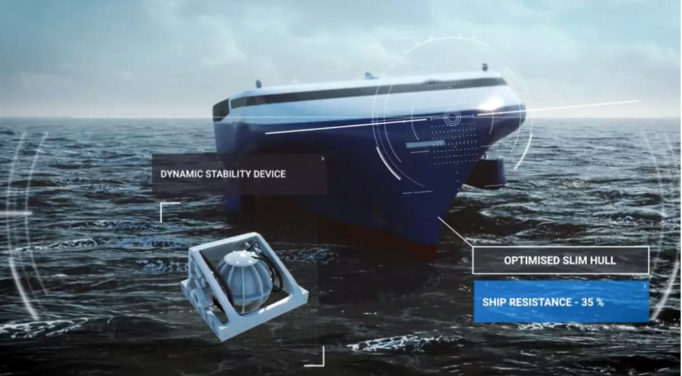
NYK Super Eco Ship 2050 concept design. Image courtesy of NYK Line
The NYK Super Eco Ship 2050 is a vessel that will be powered by hydrogen fuel cells, in which the hydrogen is produced by renewable energy sources. The vessel will require only 30% of the energy used on vessels today. The vessel will be capable of recovering waste heat from fuel cells. In addition to this, coal power from the liquefied hydrogen will be used to maximize efficiency and reduce electricity demand. A lower-weighted hull compared with traditional vessels will be achieved by using lightweight materials, bionic design, and topology optimization.
Conventional propellers will be replaced with flapping foils that mimic the movement of dolphins to deliver greater efficiency than screw-type propellers. The Super Eco Ship 2050 will use air lubrication technology to reduce the resistance between the vessel’s hull and the seawater surface. A hull-cleaning robot will carry out cleaning during port stays to reduce resistance through water. The robots will also collect debris to prevent pollution of ecological systems at port. Digital Twins will be used to give access from shore to optimize planned and corrective maintenance.
Key stats of NYK Super Eco Ship 2050:
- 67% reduction in energy derived from fossil fuels, compared with a 2014-built vessel.
- 70% reduction in energy derived from bunker fuels.
- 100% reduction in CO2 emissions.
- 1,900 m3 hydrogen capacity to provide 21 days endurance.
2. GGZEM Water-Go-Round
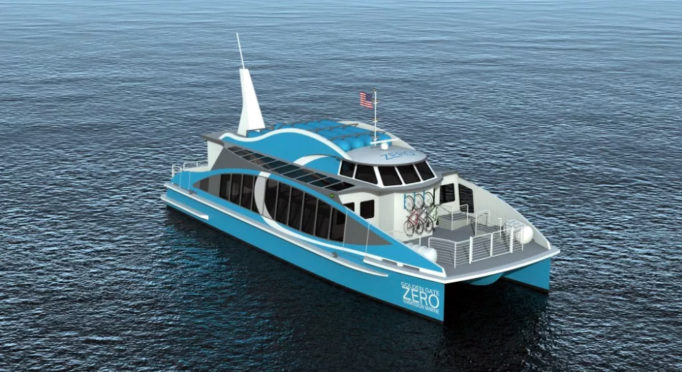
The GGZEM Water-Go-Round. Image courtesy of GGZEM
The Water-Go-Round is expected to be the first fuel cell vessel in the US and the first commercial fuel cell ferry in the world when it launches later this year. Built by Golden Gate Zero Emission Marine (GGZEM) and partners, the purpose of the vessel is to demonstrate zero-emission operation is possible. In the coming months, the vessel will begin a 3-month pilot testing phase in San Francisco. Sandia National Laboratories will independently measure the vessel’s performance. Funding comes from California Climate Investments, a state-wide program that puts billions of Cap-and-Trade dollars to work reducing greenhouse gas emissions, strengthening the economy, and improving public health and the environment.
Key stats of GGZEM Water-Go-Round:
- Speed of 22 knots achieved through two electric motors from BAE Systems with a power of 300 kW each.
- 264 kg hydrogen tank capacity, providing 2 days of operation.
3. SeaShuttle project
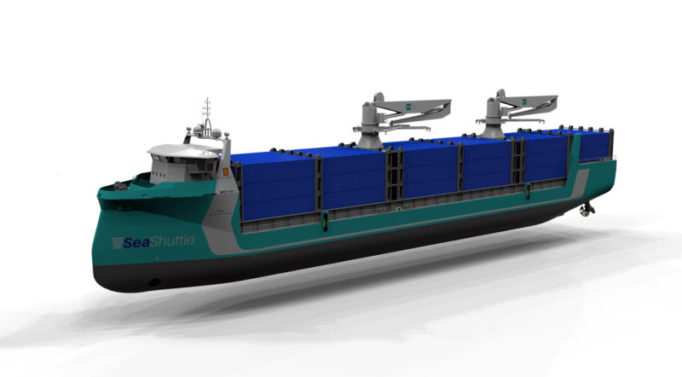
Samskip SeaShuttle. Image courtesy of Samskip
The SeaShuttle project is developing autonomous zero-emission containerships that will use hydrogen fuel cells for propulsion. Led by European operator Samskip, the vessels will use a combination of fuels and technologies to make it cost competitive and low emission. The SeaShuttle vessels will connect Poland, Sweden, and the Oslo Fjords. The project was awarded EUR 6 million by the Norwegian government to develop all-electric ships. SeaShuttle is one of six initiatives included in Pilot-E, a EUR 100m+ scheme set up by Norway to make carbon-free shipping possible by bringing market solutions to shipping more quickly.
Key stats of the Samskip SeaShuttle:
Fuel cell technology will convert hydrogen into power for propulsion in a process where electrolysis is envisaged as taking place in a Norwegian port. For the moment, the project envisages zero emissions during 20% of a round trip between Poland and the Oslo Fjord – sufficient for all operations in Norwegian waters. That proportion will grow as more stations fill hydrogen along the route.
4. Port-Liner all-electric Tesla ships
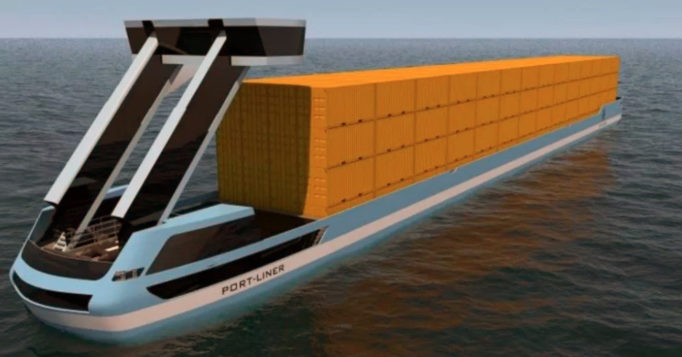
Port-Liner electric barge concept design. Image courtesy of Port Liner
Dutch company Port-Liner is building 2 large ell-electric barges expected to be launched this autumn. The vessels will initially be manned but will run autonomously once there is suitable infrastructure in place. Project cost reached EUR 100 million to date, 7 million of which is subsidized by EU. The vessels will transport containers to Antwerp, Rotterdam, and Amsterdam.
Key stats of Port-Liner all-electric Tesla ships:
- 8,000 estimated tons of CO2 reduction per year;
- 20 ft batteries providing 15 hours of continuous operation;
- 280 containers on larger vessels with power for 30 hours;
- 23,000 trucks are expected to be removed from the roads annually as a result of the first 6 barges going into operation.
5. Legacy of the Fjords
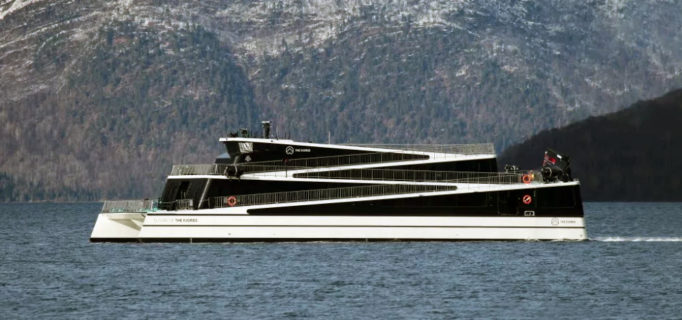
Future of The Fjords electric vessel in operation. Image courtesy of the Fjords
The Legacy of the Fjords is all-electric, zero-emission passenger vessel that has passed the concept design phase and is due to join The Fjord’s fleet in 2020. Flåm AS and Norway’s ferry company Fjord1 own The Fjord. The vessel will deploy a specially constructed Power Dock and an innovative floating charging solution that will allow it to refill its 2.4MWh battery capacity in 20 minutes. Originally planned to join the fleet in 2019, its launch has been delayed to ensure “everything is in place for this environmentally friendly, energy efficient and breath-taking new craft,” explains Vidar Hauståker, Acting CEO, The Fjords. At the current time, there are some issues with listing the required battery-loading infrastructure within the Oslo Harbor area. The vessel is made from carbon fibre sandwich material to reduce energy consumption and classed by DNV GL. Legacy of the Fjords will join Vision of The Fjords and Future of The Fjords, both currently operating with hybrid electric and electric propulsion in the Norwegian fjords. The Legacy of The Fjords is under construction at Brødrene Aa.
Key stats of Legacy of the Fjords:
- 1800 kWh battery pack;
- 2 x 450kWh el-motor;
- 400-passenger capacity.
- Liquefied hydrogen bunkering vessel
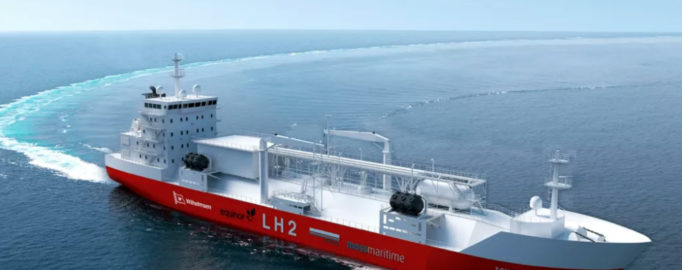
Concept design of the LH2 bunkering vessel. Image courtesy of Wilhelmsen
Last month, Moss Maritime, Equinor, Wilhelmsen, and DNV-GL, announced a design for the first liquefied hydrogen (LH2) bunker vessel indicating that transporting liquid hydrogen by sea is logistically possible. The project, sponsored by Innovation Norway, aims to clarify challenges and find solutions for storage and handling of hydrogen fuel on a vessel.
Key stats of Liquefied hydrogen bunkering vessel:
- 9,000m3 cargo capacity;
- Transportation of LH2 at a temperature of -253 °C will be possible, offering advantages over pressurized hydrogen gas in relation to transportation costs.
7. Race for Water Odyssey
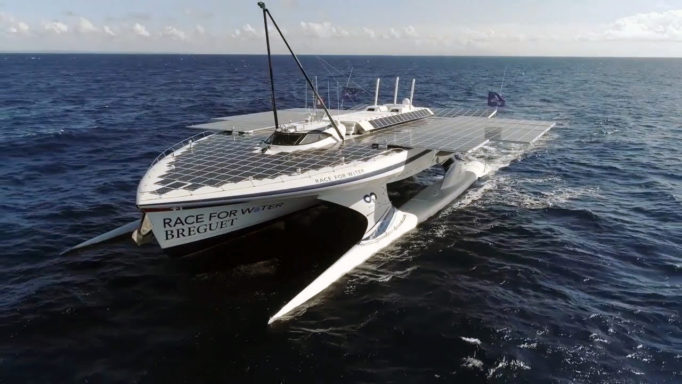
Race for Water Odyssey catamaran. Image courtesy of Raceforwater.com
The Race for Water Odyssey catamaran was developed by Swiss Hydrogen and operates using hydrogen and solar panels, making it 100% self-sufficient. The vessel began its expedition in 2017 with the purpose of raising awareness of plastic pollution in the oceans. During the day, the vessel uses solar energy to propel itself and recharge the batteries. At night, the batteries are used to keep the vessel’s power supply going. When the vessel is docked, surplus solar energy is used to produce hydrogen, which is stored in pressure tanks for use at a later point.
Plastic Omnium developed the hydrogen technology for the Race for Water vessel. “The hydrogen chain designed for the Race for Water vessel aims to demonstrate that today’s hydrogen technologies are mature, reliable and sustainable, both at sea and on land”, says Alexandre Closset, business line director, Plastic Omnium.
Key stats of Race for Water Odyssey:
- 200kg hydrogen storage on-board, enough to power the vessel for 6-7 days;
- 30kW fuel cells to convert the hydrogen back to electricity;
- 8 knots sailing speed possible;
- 8 tons of lithium-ion batteries provide a 36-hour energy range;
- 512m2 of solar panel storage.
8. Dual-electric Chinese cargo ship
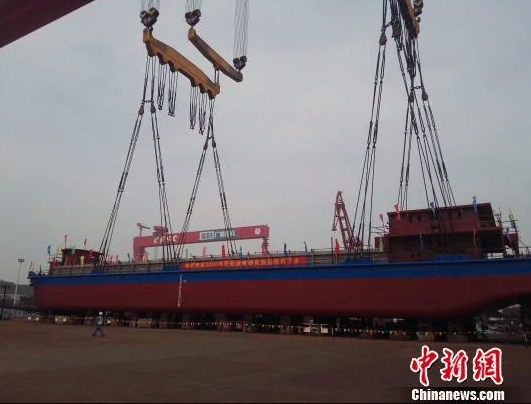
Guangzhou Shipyard dual-electric cargo ship. Image courtesy of China News
In November 2017, the Guangzhou Shipyard international launched a dual-electric cargo ship to sail in inland waters of the Pearl Delta. Powered by lithium batteries, a super capacitor, and two electric motors, the vessel emits no carbon, SOx or PM2.5 particulates. According to China News, the vessel represents a breakthrough in the design difficulties of large-capacity new electric ships and shore-power connectivity to provide efficient energy recovery as well as strong ship power. The China Classification Society (CCS) certified the vessel.
Key stats Dual-electric Chinese cargo ship:
- Two 160 kW electric propellers;
- Total energy capacity of 2.4 MWh via a 26-ton super-capacitor + ultra-high-power lithium battery;
- Operational time of two hours and up to 80km;
- 7 knots sailing speed.
